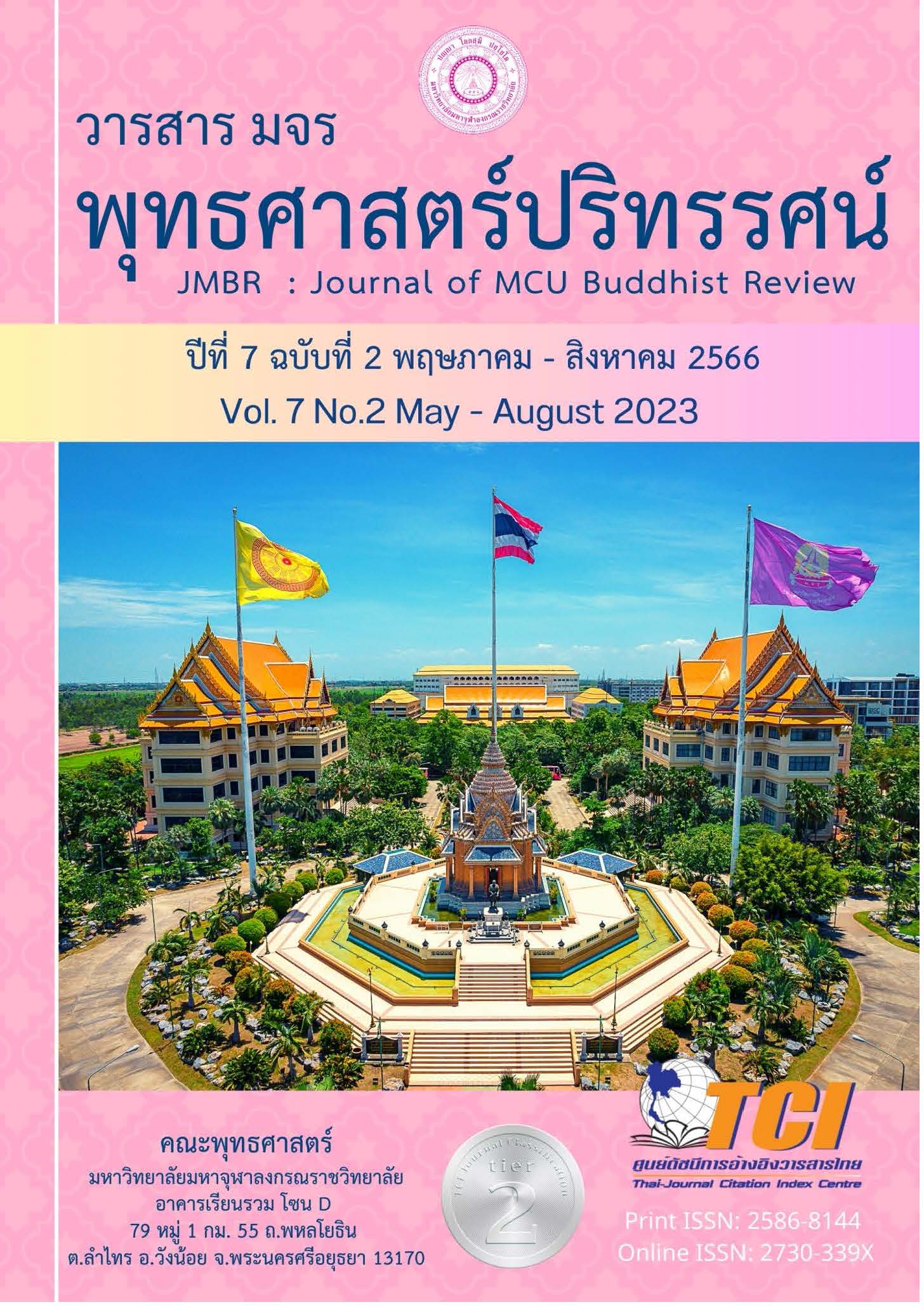การกำหนดรูปนามที่ปรากฏในอานาปานสติสูตร
Main Article Content
บทคัดย่อ
บทความวิจัยนี้มีวัตถุประสงค์ 1) เพื่อศึกษาโครงสร้างและสาระสำคัญที่ปรากฏใน
อานาปานสติสูตร 2) เพื่อศึกษาการกำหนดรูปนามที่ปรากฏในอานาปานสติสูตร และ 3) เพื่อวิเคราะห์แนวทางการปฏิบัติการกำหนดรูปนามในอานาปานสติสูตร เป็นการวิจัยเอกสาร วิเคราะห์ข้อมูลเชิงพรรณนา
ผลการวิจัยพบว่า 1) อานาปานสติสูตร ปรากฏในพระไตรปิฎกเล่มที่ 14 มัชฌิมนิกาย
อุปริปัณณาสก์ อนุปทวรรค เป็นการเจริญอานาปานสติ 16 ขั้น อานาปานสติบริบูรณ์ทำให้สติปัฏฐาน 4 โพชฌงค์ 7 วิชชาและวิมุตติ บริบูรณ์ เราเป็นประธาน ทำหน้าที่กำหนดกาย เวทนา จิต ธรรม เราจึงมีปัญญารู้หน้าที่กาย เวทนา จิต ธรรม อาศัยกันเกิดขึ้น ไม่เป็นตัวตน 2) การกำหนดรูปนามที่ปรากฏในอานาปานสติสูตรและอานาปานสติกถา ในทุกขั้นจิตทำหน้าที่กำหนดรู้รูป คือลมหายใจเข้าออก และจิตกำหนดรู้นาม ธรรมทั้งหลายที่เกิดจากจิต เนื่องด้วยจิต จิตมีปัญญารู้หน้าที่รูปนาม อาศัยกันเกิดขึ้นไม่เป็นตัวตน 3) แนวทางการปฏิบัติการกำหนดรูปนามในอานาปานสติสูตร อุบายฝึกให้เข้าถึงปรมัตถ์ เริ่มต้นกำหนด จิตเป็นประธาน คุมลม รู้ตามลม สร้างปัญญา จิตคุมลม จิตไม่ใช่ลม จิตรู้ตามลม ลมสร้างจิต เจริญฌานไปตามลำดับ จิตมีปัญญาเห็นจิตไม่เที่ยง เป็นทุกข์ เป็นอนัตตา สำเร็จตามเป้าหมาย นำอุบายมาใช้ในชีวิตประจำวัน ดำเนินชีวิตเป็นกุศล พัฒนาตน เป็นประโยชน์ พ้นอบายภูมิ
Article Details

อนุญาตภายใต้เงื่อนไข Creative Commons Attribution-NonCommercial-NoDerivatives 4.0 International License.
- บทความที่ได้รับการตีพิมพ์เป็นลิขสิทธิ์ของวารสาร มจร พุทธศาสตร์ปริทรรศน์
- ข้อความใดๆ ที่ปรากฎในบทความที่ได้รับการตีพิมพ์ในวารสาร ถือเป็นความรับผิดชอบของผู้เขียนบทความ และข้อคิดเห็นนั้นไม่ถือว่าเป็นทัศนะและความรับผิดชอบของกองบรรณาธิการวารสาร มจร พุทธศาสตร์ปริทรรศน์
เอกสารอ้างอิง
คณะวิปัสสนาบาลี วัดพุทธศาสตร์. (2566). คณะวิปัสสนาบาลี อำเภอเกาะจันทร์ จังหวัดชลบุรี. ชลบุรี: ออฟ กราฟฟิก.
ไทยพีบีเอส. (9 พฤษภาคม 2566). ศาลไม่ให้ประกันตัวดีเจแมน-ใบเตย คดี Forex-3D. สืบค้น 9 พฤษภาคม 2566 จาก https://www.thaipbs.or.th/news/content/327535.
ไทยรัฐออนไลน์. (11 พฤษภาคม 2566). ระทึก แผ่นดินไหวรุนแรงขนาด 5.4 เขย่าญี่ปุ่น สถานทูตแจ้งคนไทยในพื้นที่ระวังตัว. สืบค้น 11 พฤษภาคม 2566 จาก https://www.thairath.co.th/news/foreign /2692970.
พระธรรมโกศาจารย์ (พุทธทาสภิกขุ). (2564). คู่มือปฏิบัติอานาปานสติ. กรุงเทพฯ: ธรรมสภา.
พระพุทธโฆสเถระ. (2562). คัมภีร์วิสุทธิมรรค. แปลโดย สมเด็จพระพุฒาจารย์ (อาจ อาสภมหาเถร). พิมพ์ครั้งที่ 14. จีน: ม.ป.พ.
พระมหาสมปอง มุทิโต. (2547). คัมภีร์อภิธานวรรณนา. พิมพ์ครั้งที่ 2. กรุงเทพฯ: ประยูรวงศ์พริ้นท์ติ้งจำกัด.
พระสัทธัมมโชติกะ ธัมมาจริยะ. (2563). ปรมัตถโชติกะ ปริจเฉทที่ 3 และ ปริจเฉทที่ 7. กรุงเทพฯ: หจก.ทิพยวิสุทธิ์.
พุทธทาส อินฺทปญฺโญฃ. (2558). อานาปานสติภาวนา. พิมพ์ครั้งที่ 14. กรุงเทพฯ: ธรรมสภา.
มหาวิทยาลัยมหาจุฬาลงกรณราชวิทยาลัย. (2535). พระไตรปิฎกภาษาบาลี ฉบับมหาจุฬาเตปิฏกํ 2500. กรุงเทพฯ: มหาจุฬาลงกรณราชวิทยาลัย.
มหาวิทยาลัยมหาจุฬาลงกรณราชวิทยาลัย. (2539). พระไตรปิฎกภาษาไทย ฉบับมหาจุฬาลงกรณราชวิทยาลัย เฉลิมพระเกียรติสมเด็จพระนางเจ้าสิริกิติ์ พระบรมราชินีนาถ. กรุงเทพฯ: มหาจุฬาลงกรณราชวิทยาลัย.
มหาวิทยาลัยมหาจุฬาลงกรณราชวิทยาลัย. (2552). อรรถกถาภาษาไทย ฉบับมหาวิทยาลัยมหาจุฬาลงกรณราชวิทยาลัย. กรุงเทพฯ: มหาจุฬาลงกรณราชวิทยาลัย.


